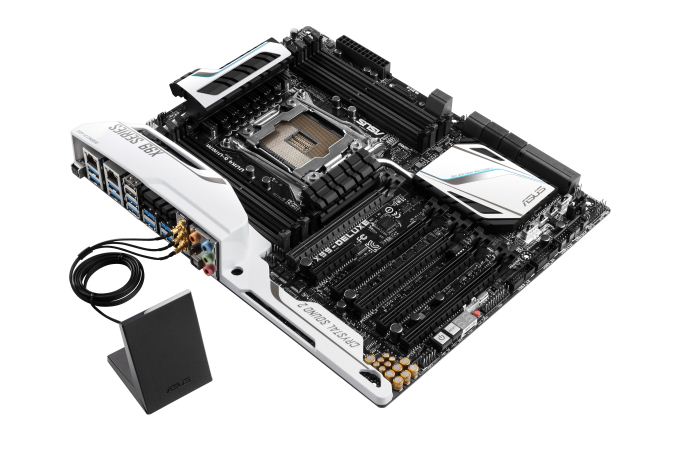The Intel Haswell-E X99 Motherboard Roundup with ASUS, GIGABYTE, ASRock and MSI
by Ian Cutress on September 25, 2014 11:30 AM ESTASUS X99-Deluxe Conclusion
A lot of positive remarks have been made about the styling of the X99-Deluxe. There has been no modern attempt to style white and black properly on the motherboard, and when taking the product out of the packaging it does feel like there is a touch of finesse to the product. This may be derived purely from the white strip down the left hand side covering some of the PCB and the rear panel and the consistency in the visual aesthetic. On closer inspection, it does come to realize that the white strip is plastic and only there for the aesthetic value, but to ASUS’ credit it does look smooth and proud.
The X99-Deluxe is the most expensive X99 motherboard in our first set of reviews at $400, and actually sits near the top of the entire X99 stack. As a result, it has new or exciting features coming out of every corner. We discussed the new features such as the OC Socket to help with overclocking, the vertical M.2 x4 slot for drives and the multi-GPU switch that lights up the PCIe slots where GPUs should be placed for 2/3-way gaming. Also included in the box are a Hyper M.2 x4 PCIe card for more storage and an antenna for the 3T3R 802.11ac module – the X99-Deluxe is currently the only motherboard with a tri-stream 802.11ac solution integrated into the platform.
The more usual bonus features include dual SATA Express ports, dual Intel network connections and Crystal Sound 2 which translates as an improved ALC1150 codec with EMI shields, de-pop circuits, PCB separation and impedance detection. ASUS has also introduced a fan extension PCB, supporting another three four-pin headers alongside the six already on the motherboard. This comes with an adhesive strip, allowing system designers to place the fan PCB near where it is needed. All the fans are DC and PWM controllable as well.
The performance of the ASUS X99-Deluxe is a little mixed. Overclocking results give it 4.6 GHz under 95C load temperatures, and audio results put it at the top of our X99 charts. DPC Latency is in the middle but still very good, with POST times around the 21 second mark similar to the other motherboards. Power consumption is also in the middle.
Unfortunately though the CPU performance at stock seems a little down compared to the others. We have tackled the issue of MultiCore Turbo previously at AnandTech, and the i7-5960X is odd that while it has a base frequency of 3.0 GHz, the 3.5 GHz turbo mode is quite rare and the CPU sits more happily at 3.3 GHz. It would seem that the ASUS X99-Deluxe does implement a form of MultiCore Turbo, although slightly less aggressive than some of the other motherboards. As a result, CPU performance at stock is a little down (1145 in 3DPM-MT vs 1271 for MSI). But, when overclocked, the ASUS seems to perform better than other motherboards (PovRay at 4.0 GHz, ASUS 3223 vs MSI 3121) so it does not come across as big worry – just place the system in TPU mode one and away you go.
It is easy to be impressed with the ASUS X99-Deluxe. Not only the design, but the BIOS, software and extra features all give it a boost above most of the X99 products on the market right now. Simple things like the XMP switch and the multi-GPU light-up LEDs improve the experience, while the bundled Hyper M.2 x4 PCIe card and 802.11ac 3T3R WiFi module give tangible benefits to spending over the average.
For the X99 launch, ASUS launched only two models to the North American market – this X99 Deluxe and the $500 Rampage V Extreme. The X99-A, X99-Pro and X99-WS are all in the pipeline, but it still means ASUS is focusing more on fewer motherboards giving time to improve each one. The argument from other manufacturers is that having more motherboards offers more choice, although if you want something like the X99-Deluxe, it is a polished product and hits the market it needs to with a wake-up call.
I enjoyed the X99-Deluxe. Most X99 users will too. Out of the motherboards tested today, it certainly deserves to be recommended for an i7-5960X build.
ASUS X99-Deluxe












62 Comments
View All Comments
nathanddrews - Thursday, September 25, 2014 - link
So which system will serve as the new 2015 gaming review platform? Also, OC + GTX 980 OC Quad-SLI? ;-)techxx - Thursday, September 25, 2014 - link
Why are these things so damn expensive? I was hoping for a Mini-ITX for low $100s.Flunk - Thursday, September 25, 2014 - link
X99 is the workstation/enthusiate platform. You're not likely to see any mini-ITX boards at all, certainly not for $100. Maybe you're thinking of Z97?techxx - Thursday, September 25, 2014 - link
Was right about to correct my post. Yup.Ian Cutress - Thursday, September 25, 2014 - link
We recently reviewed three Z97 mini-ITX at $140 :) http://anandtech.com/show/8276/z97-miniitx-review-...BubbaJoe TBoneMalone - Thursday, September 25, 2014 - link
ASUS Shadowcat x99 mini-itx with usb 3.1 in the works -> http://rog.asus.com/325712014/asus-gaming-motherbo...korben44 - Thursday, September 25, 2014 - link
Sorry, but that Shadowcat is not X99... X99 CPUs do not have onboard graphics chips...editorsorgtfo - Sunday, May 17, 2015 - link
ASRock X99E-ITX/ac but at around 300.just4U - Thursday, September 25, 2014 - link
I'd like to see what they have on the go for MATX.y2kBug - Thursday, September 25, 2014 - link
It's nice to see that these motherboards support Xeon CPUs. Though, does anybody know if Haswell-E Xeons are overclockable? Probably not, but it is nice to know that you can upgrade your machine with 8-Core Xeon in a few years cheaply when big data centers start getting rid of them while upgrading to something new (similar to what is happening to Nehalem/Westmere Xeons now).